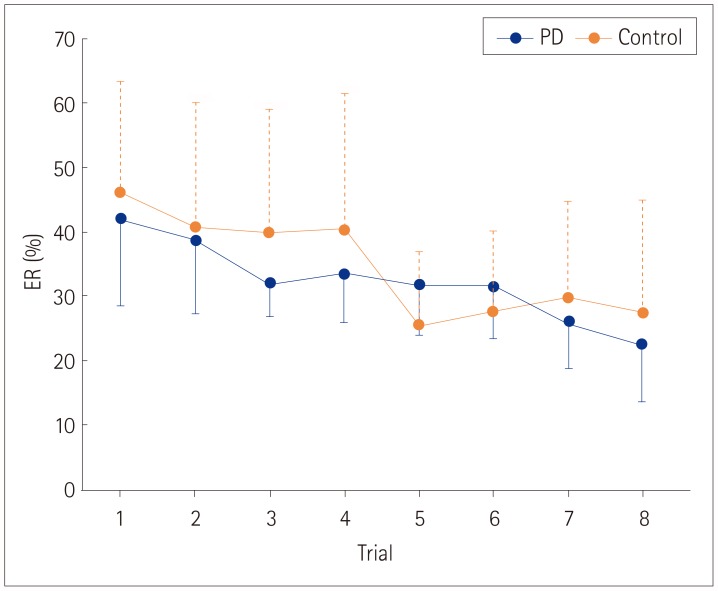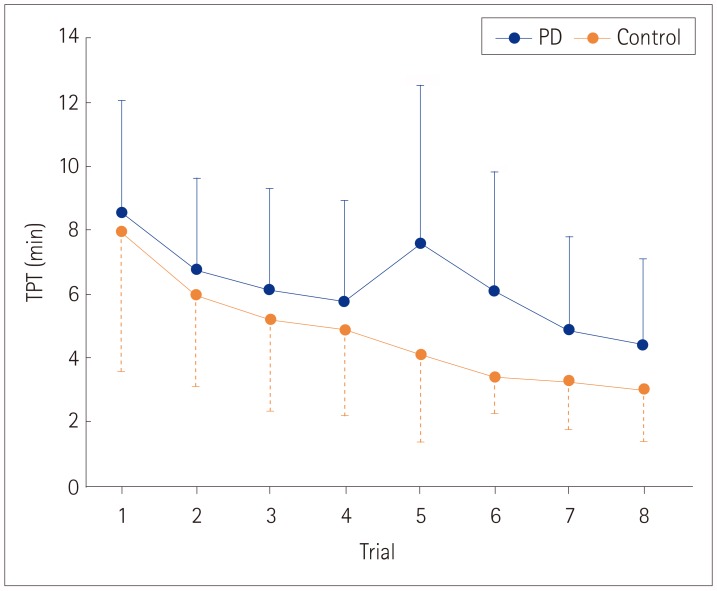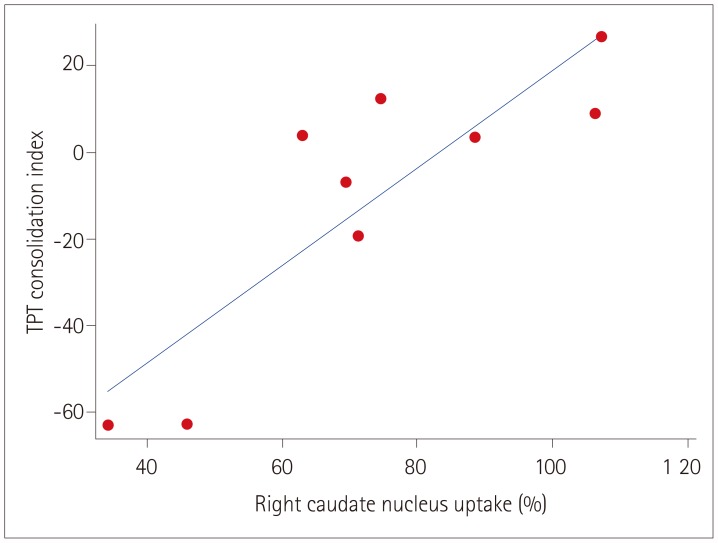J Clin Neurol.
2018 Oct;14(4):505-512. 10.3988/jcn.2018.14.4.505.
Consolidation of a Learned Skill Correlates with Dopamine SPECT Uptake in Early Parkinson's Disease
- Affiliations
-
- 1Division of Neurorehabilitation, Geneva University Hospitals, Geneva, Switzerland. nn311@medschl.cam.ac.uk
- 2Department of Psychiatry, University of Cambridge, Cambridge, United Kingdom.
- 3Laboratory of Cognitive Neurorehabilitation, Geneva University Hospitals, Geneva, Switzerland.
- 4Division of Nuclear Medicine and Molecular Imaging, Geneva University Hospitals, Geneva, Switzerland.
- 5Faculty of Medicine, Geneva University, Geneva, Switzlerland.
- 6Division of Neurology, Department of Clinical Neurosciences, Geneva University Hospitals, Geneva, Switzerland.
- KMID: 2424179
- DOI: http://doi.org/10.3988/jcn.2018.14.4.505
Abstract
- BACKGROUND AND PURPOSE
Basal ganglia play a pivotal role in procedural memory. However, the correlation between skill learning and striatal 123I-ioflupane uptake in Parkinson's disease (PD) has not been reported previously. Our objective was to determine whether visuomotor skill learning is associated with striatal 123I-ioflupane uptake in early PD.
METHODS
We designed a case-control study to assess learning and consolidation of a visuomotor learning task (mirrored drawing of star-shaped figures) performed on two consecutive days by early-PD patients (disease duration < 2 years) and age-matched healthy subjects. Outcomes were the error rate and time per trial, as well as performance indices to assess the relative improvement on the first day (learning) and the retention on the second day (consolidation). For PD patients, we evaluated the correlation of skill learning with semiquantitative 123I-ioflupane uptake.
RESULTS
We included 9 PD patients and 10 control subjects with the same baseline characteristics (age, male/female ratio, educational level, Mini Mental State Examination score, and Hospital Anxiety and Depression Scale score, all p>0.18) other than the score on part III of the Movement Disorders Society Unified Parkinson's Disease Rating Scale, which was higher in the PD patients (mean±SD: 15.0±10.4 vs. 1.3±1.1, p < 0.001). The learning indices were the same in the two groups (p>0.5), whereas PD patients showed a lower consolidation index for the time per trial (p=0.009). Moreover, this performance was correlated with uptake in the right caudate nucleus (Spearman's rho=0.82, p=0.007) and the right striatum (Spearman's rho=0.67, p=0.049), including when multiple linear regression adjusting for the levodopa equivalent daily dose was performed (p=0.005 for the caudate nucleus and p=0.024 for the striatum).
CONCLUSIONS
This study provides evidence of a correlation between procedural memory impairment and striatal dopaminergic dysfunction in early PD.
Keyword
MeSH Terms
Figure
Reference
-
1. Scoville WB, Milner B. Loss of recent memory after bilateral hippocampal lesions. J Neurol Neurosurg Psychiatry. 1957; 20:11–21. PMID: 13406589.
Article2. Cohen NJ, Squire LR. Preserved learning and retention of pattern-analyzing skill in amnesia: dissociation of knowing how and knowing that. Science. 1980; 210:207–210. PMID: 7414331.
Article3. Squire LR. Declarative and nondeclarative memory: multiple brain systems supporting learning and memory. J Cogn Neurosci. 1992; 4:232–243. PMID: 23964880.
Article4. Jahanshahi M, Obeso I, Rothwell JC, Obeso JA. A fronto-striato-subthalamic-pallidal network for goal-directed and habitual inhibition. Nat Rev Neurosci. 2015; 16:719–732. PMID: 26530468.
Article5. Doyon J, Benali H. Reorganization and plasticity in the adult brain during learning of motor skills. Curr Opin Neurobiol. 2005; 15:161–167. PMID: 15831397.
Article6. Müller NC, Genzel L, Konrad BN, Pawlowski M, Neville D, Fernández G, et al. Motor skills enhance procedural memory formation and protect against age-related decline. PLoS One. 2016; 11:e0157770. PMID: 27333186.
Article7. Saint-Cyr JA, Taylor AE, Lang AE. Procedural learning and neostriatal dysfunction in man. Brain. 1988; 111:941–959. PMID: 2969762.8. Schnider A, Gutbrod K, Hess CW. Motion imagery in Parkinson's disease. Brain. 1995; 118:485–493. PMID: 7735889.
Article9. Thomas-Ollivier V, Reymann JM, Le Moal S, Schück S, Lieury A, Allain H. Procedural memory in recent-onset Parkinson's disease. Dement Geriatr Cogn Disord. 1999; 10:172–180. PMID: 10026393.
Article10. Stefanova ED, Kostic VS, Ziropadja L, Markovic M, Ocic GG. Visuomotor skill learning on serial reaction time task in patients with early Parkinson's disease. Mov Disord. 2000; 15:1095–1103. PMID: 11104191.
Article11. Terpening Z, Naismith S, Melehan K, Gittins C, Bolitho S, Lewis SJ. The contribution of nocturnal sleep to the consolidation of motor skill learning in healthy ageing and Parkinson's disease. J Sleep Res. 2013; 22:398–405. PMID: 23398021.
Article12. Muslimovic D, Post B, Speelman JD, Schmand B. Motor procedural learning in Parkinson's disease. Brain. 2007; 130:2887–2897. PMID: 17855374.
Article13. Stephan MA, Meier B, Zaugg SW, Kaelin-Lang A. Motor sequence learning performance in Parkinson's disease patients depends on the stage of disease. Brain Cogn. 2011; 75:135–140. PMID: 21134706.
Article14. Booth TC, Nathan M, Waldman AD, Quigley AM, Schapira AH, Buscombe J. The role of functional dopamine-transporter SPECT imaging in parkinsonian syndromes, part 1. AJNR Am J Neuroradiol. 2015; 36:229–235. PMID: 24904053.
Article15. Nicastro N, Garibotto V, Poncet A, Badoud S, Burkhard PR. Establishing on-site reference values for (123)I-FP-CIT SPECT (DaTSCAN®) using a cohort of individuals with non-degenerative conditions. Mol Imaging Biol. 2016; 18:302–312. PMID: 26341194.
Article16. Nicastro N, Garibotto V, Badoud S, Burkhard PR. Scan without evidence of dopaminergic deficit: a 10-year retrospective study. Parkinsonism Relat Disord. 2016; 31:53–58. PMID: 27421952.
Article17. Nicastro N, Garibotto V, Allali G, Assal F, Burkhard PR. Added value of combined semi-quantitative and visual [123I]FP-CIT SPECT analyses for the diagnosis of dementia with Lewy bodies. Clin Nucl Med. 2017; 42:e96–e102. PMID: 27941373.
Article18. Nicastro N, Burkhard PR, Garibotto V. Scan without evidence of dopaminergic deficit (SWEDD) in degenerative parkinsonism and dementia with Lewy bodies: a prospective study. J Neurol Sci. 2018; 385:17–21. PMID: 29406901.
Article19. Zigmond AS, Snaith RP. The hospital anxiety and depression scale. Acta Psychiatr Scand. 1983; 67:361–370. PMID: 6880820.
Article20. Folstein MF, Folstein SE, McHugh PR. “Mini-mental state”. A practical method for grading the cognitive state of patients for the clinician. J Psychiatr Res. 1975; 12:189–198. PMID: 1202204.21. Goetz CG, Tilley BC, Shaftman SR, Stebbins GT, Fahn S, Martinez-Martin P, et al. Movement Disorder Society-sponsored revision of the Unified Parkinson's Disease Rating Scale (MDS-UPDRS): scale presentation and clinimetric testing results. Mov Disord. 2008; 23:2129–2170. PMID: 19025984.
Article22. Milner B. Physiologie de l'hippocampe. Paris: Centre National de la Recherche Scientifique;1962.23. Salas-Gonzalez D, Górriz JM, Ramírez J, Illán IA, Padilla P, Martínez-Murcia FJ, et al. Building a FP-CIT SPECT template using a posterization approach. Neuroinformatics. 2015; 13:391–402. PMID: 25749984.24. Mazziotta JC, Toga AW, Evans A, Fox P, Lancaster J. A probabilistic atlas of the human brain: theory and rationale for its development. The International Consortium for Brain Mapping (ICBM). Neuroimage. 1995; 2:89–101. PMID: 9343592.25. Maldjian JA, Laurienti PJ, Kraft RA, Burdette JH. An automated method for neuroanatomic and cytoarchitectonic atlas-based interrogation of fMRI data sets. Neuroimage. 2003; 19:1233–1239. PMID: 12880848.
Article26. Faul F, Erdfelder E, Buchner A, Lang AG. Statistical power analyses using G*Power 3.1: tests for correlation and regression analyses. Behav Res Methods. 2009; 41:1149–1116. PMID: 19897823.
Article27. Siegert RJ, Taylor KD, Weatherall M, Abernethy DA. Is implicit sequence learning impaired in Parkinson's disease? A meta-analysis. Neuropsychology. 2006; 20:490–495. PMID: 16846267.
Article28. Marinelli L, Crupi D, Di Rocco A, Bove M, Eidelberg D, Abbruzzese G, et al. Learning and consolidation of visuo-motor adaptation in Parkinson's disease. Parkinsonism Relat Disord. 2009; 15:6–11. PMID: 18424221.
Article29. Doyon J, Laforce R Jr, Bouchard G, Gaudreau D, Roy J, Poirier M, et al. Role of the striatum, cerebellum and frontal lobes in the automatization of a repeated visuomotor sequence of movements. Neuropsychologia. 1998; 36:625–641. PMID: 9723934.
Article30. Nobili F, Campus C, Arnaldi D, De Carli F, Cabassi G, Brugnolo A, et al. Cognitive-nigrostriatal relationships in de novo, drug-naïve Parkinson's disease patients: a [I-123]FP-CIT SPECT study. Mov Disord. 2010; 25:35–43. PMID: 20058228.
Article31. Siepel FJ, Brønnick KS, Booij J, Ravina BM, Lebedev AV, Pereira JB, et al. Cognitive executive impairment and dopaminergic deficits in de novo Parkinson's disease. Mov Disord. 2014; 29:1802–1808. PMID: 25284687.32. Pellecchia MT, Picillo M, Santangelo G, Longo K, Moccia M, Erro R, et al. Cognitive performances and DAT imaging in early Parkinson's disease with mild cognitive impairment: a preliminary study. Acta Neurol Scand. 2015; 131:275–281. PMID: 25644029.
Article33. Beauchamp MH, Dagher A, Aston JA, Doyon J. Dynamic functional changes associated with cognitive skill learning of an adapted version of the Tower of London task. Neuroimage. 2003; 20:1649–1660. PMID: 14642475.
Article34. Dagher A, Owen AM, Boecker H, Brooks DJ. The role of the striatum and hippocampus in planning: a PET activation study in Parkinson's disease. Brain. 2001; 124:1020–1032. PMID: 11335704.
Article35. Moody TD, Bookheimer SY, Vanek Z, Knowlton BJ. An implicit learning task activates medial temporal lobe in patients with Parkinson's disease. Behav Neurosci. 2004; 118:438–442. PMID: 15113271.
Article36. Alexander GE, DeLong MR, Strick PL. Parallel organization of functionally segregated circuits linking basal ganglia and cortex. Annu Rev Neurosci. 1986; 9:357–381. PMID: 3085570.
Article37. Cummings JL. Frontal-subcortical circuits and human behavior. Arch Neurol. 1993; 50:873–880. PMID: 8352676.
Article38. Rodriguez-Oroz MC, Jahanshahi M, Krack P, Litvan I, Macias R, Bezard E, et al. Initial clinical manifestations of Parkinson's disease: features and pathophysiological mechanisms. Lancet Neurol. 2009; 8:1128–1139. PMID: 19909911.
Article39. Balleine BW, Delgado MR, Hikosaka O. The role of the dorsal striatum in reward and decision-making. J Neurosci. 2007; 27:8161–8165. PMID: 17670959.
Article40. Balleine BW, O'Doherty JP. Human and rodent homologies in action control: corticostriatal determinants of goal-directed and habitual action. Neuropsychopharmacology. 2010; 35:48–69. PMID: 19776734.
Article41. Floyer-Lea A, Matthews PM. Changing brain networks for visuomotor control with increased movement automaticity. J Neurophysiol. 2004; 92:2405–2412. PMID: 15381748.
Article42. Carbon M, Ma Y, Barnes A, Dhawan V, Chaly T, Ghilardi MF, et al. Caudate nucleus: influence of dopaminergic input on sequence learning and brain activation in Parkinsonism. Neuroimage. 2004; 21:1497–1507. PMID: 15050574.
Article43. Simon SR, Meunier M, Piettre L, Berardi AM, Segebarth CM, Boussaoud D. Spatial attention and memory versus motor preparation: premotor cortex involvement as revealed by fMRI. J Neurophysiol. 2002; 88:2047–2057. PMID: 12364527.
Article44. van Belle J, Vink M, Durston S, Zandbelt BB. Common and unique neural networks for proactive and reactive response inhibition revealed by independent component analysis of functional MRI data. Neuroimage. 2014; 103:65–74. PMID: 25224995.
Article45. Winogrodzka A, Bergmans P, Booij J, van Royen EA, Janssen AG, Wolters EC. [123I]FP-CIT SPECT is a useful method to monitor the rate of dopaminergic degeneration in early-stage Parkinson's disease. J Neural Transm (Vienna). 2001; 108:1011–1019. PMID: 11716136.
- Full Text Links
- Actions
-
Cited
- CITED
-
- Close
- Share
- Similar articles
-
- Clinical Significance of 123I-IPT SPECT for the Diagnosis of the Parkinson's Disease
- Dopamine Receptors and Agonists in Parkinson's Disease
- SPECT Imaging of Dopamine Transporter with [I-123] IPT in Normal Controls and Parkinson's Patients
- Dopamine Transporter Imaging in Neurodegenerative Disorders
- Differentiation of Parkinson's Disease and Essential Tremor on I-123 IPT(I-123-N-(3-iodopropen-2-yl)-2beta-carbomethoxy-3beta(4-cholorophenyl) tropane) Brain SPECT




